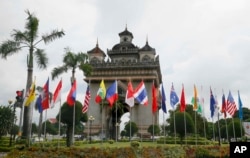China is likely to come away from a regional meeting of defense leaders this month with tentative new support around Asia, bolstering its expansion in a disputed sea, according to regional analysts.
Defense ministers from China and up to 10 countries in Southeast Asia – some resentful of Beijing’s maritime ambitions – will meet October 18-20 at the Association of Southeast Asian Nations (ASEAN) event. Defense heads from Japan and the United States, both of which have pushed back against Beijing’s expansion, are also scheduled to attend.
Association members Brunei, Malaysia, the Philippines and Vietnam claim parts of the South China Sea, overlapping tracts controlled by the more militarily powerful China. China calls about 90 percent of the sea its own. The 3.5 million-square-kilometer sea is prized for fisheries, oil, gas and shipping lanes.
Southeast Asian defense heads will go soft on China because they hope to work with it more on maritime safety or economic initiatives such as joint energy exploration, experts say. China in turn gets a tacit go-ahead to keep expanding in the contested waterway, they add.
“We know the two main claimant countries are not in the vibe to criticize China at this time,” said Yun Sun, East Asia Program senior associate at the Stimson Center think tank in Washington. “Vietnam has its domestic political consolidation and the strengthened political ties with China. The Philippines is not yet finished with its current friendly tide with China.”
Becoming better friends
Vietnam has clashed with China periodically since the 1970s and the two sides now spar over oil tracts in their overlapping claims. In 2012 China took control of a shoal frequented by Filipino fishing boats and located in Manila’s exclusive economic zone. U.S. and Japanese vessels have helped both Southeast Asian countries bolster their defenses.
But at the annual ASEAN Defense Ministers Meeting defense ministers will probably seek “open-ended confidence building” opportunities with Beijing, said Alan Chong, associate professor at the S. Rajaratnam School of International Studies in Singapore.
They will try at the meeting in Singapore to push for speeding up talks on a South China Sea code of conduct aimed at avoiding mishaps, analysts believe. The code would avoid touching on anyone’s sovereignty claims. ASEAN and China agreed last year to start those negotiations after years of stalling by Beijing.
“Within ASEAN, when you talk about the South China Sea, the default consideration is always the support for the code of conduct, so I think we’re going to go back to that,” said Herman Kraft, political science professor at the University of the Philippines Diliman in Manila.
“The main issue would be to try to get the discussions on the code of conduct moving forward and trying to find ways in which that could be completed as soon as possible,” he said.
Any statements from the meeting will avoid criticizing China, especially in name, said Carl Thayer, professor emeritus with the University of New South Wales in Australia. Ministers might call just for “restraint” in the sea or for avoiding “escalation of conflict,” he said.
The Philippines is aiming to sign a deal with China to explore part of the sea together for deposits of gas and oil, Kraft noted. Vietnam looks to China as a source of trade, investment and tourism.
Gains for China
China will gain from the event first by avoiding open criticism from Japan and the United States, scholars say. Southeast Asian leaders, particularly China’s staunch ally Cambodia, would mute anything too harsh, Thayer said.
Japanese Prime Minister Shinzo Abe is due to visit Beijing, so his government is unlikely to soil the defense meeting, Chong said. He will travel October 25-27.
“I don’t see anything negative or anything that would upset China coming in that,” Thayer said. “It’s all generalities that stays within the wording that ASEAN has already issued. I can’t see that particularly changing.”
Chinese defense officials could technically use the ASEAN event to talk with U.S. counterparts about rekindling cooperation. China blocked a U.S. warship due to visit Hong Kong this month after Washington sanctioned the Chinese military over its purchases of Russian weapons.
Beijing may be able to finish militarizing islands before the code of conduct is signed, Chong suggested. The code, he said, is unlikely to be signed this year.
Over roughly the past decade, China has reclaimed land to build islets in the sea’s Paracel chain and the heavily contested Spratly Islands. This year to date, Beijing has parked missiles, held naval drills and considered floating nuclear power stations in the sea that runs from Hong Kong to the island of Borneo.
“It may have actually consciously planned to complete the militarization of the islands it currently controls, so it could be stalling ASEAN for time,” Chong said.








